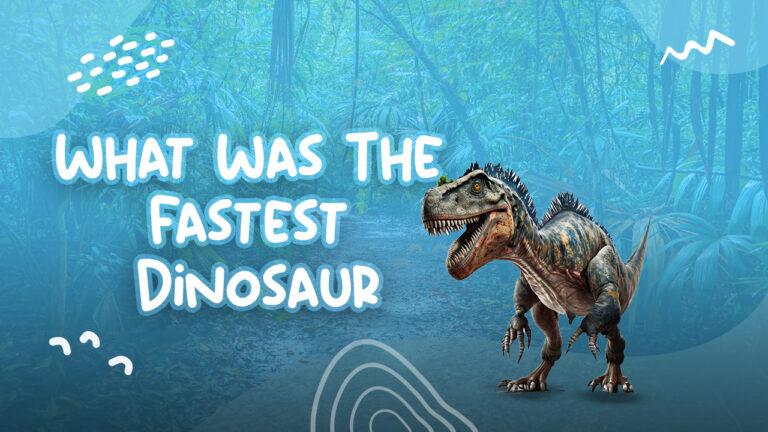What Was The Fastest Dinosaur?

Speed was not the most common and not the best strength of dinosaurs. However, among these towering and massive creatures, have you ever wondered what was the fastest dinosaur?
In this article, we can trace the dinosaurs’ speed through their only remains, their fossils. Together, let us uncover what was the fastest dinosaur in their prevailing time.
How To Measure What Was The Fastest Dinosaur
We can only come up with the answer on what was the fastest dinosaur once we meticulously measured their speed. An interesting fact is how fast two-legged dinosaurs can run so fast. This actually contradicts the notion in today’s time that mammals with four legs are the fastest.
Concludingly, during the prehistoric time, more legs isn’t always the fastest. Now, how do we measure what was the fastest dinosaur through the characteristics below.
Fossil Evidence
The fossilized footprints of dinosaurs left us with important information about how they walked and ran. Using the dinosaur footprint tracks helps scientists to calculate their speed.
Fossil evidence is the most direct way to measure the speed of a dinosaur. By studying the fossilized bones of a dinosaur, scientists can determine the size and shape of the animal, as well as the length of its limbs. This information can then be used to calculate the maximum speed the dinosaur could have achieved.
Anatomical Feature
Dinosaur speed varied with their size, weight, and anatomy, with smaller and lighter dinosaurs likely moving faster than their larger counterparts. “What was the fastest dinosaur?” This question prompts scientists to examine dinosaur leg bones and biomechanics, using fossil evidence, biomechanical analysis, and computer modeling to estimate their speed. This approach helps determine the fastest dinosaur by analyzing how their muscles and bones worked together for movement, making it a detailed study to understand their maximum speed capabilities.
Computer Modeling
Computer modeling represents the third method for gauging dinosaur speed. Through constructing a digital model of the dinosaur, scientists can simulate its movements and potential speeds, sparking the question, “What was the fastest dinosaur?”
This approach is particularly valuable for studying extinct species, enabling researchers to explore dinosaur behavior beyond the limitations of fossil records and contribute to the discussion on “What was the fastest dinosaur?”
What Was The Top 5 Fastest Dinosaur
To prove who was the fastest dinosaur, let us break down the most promising contenders for the title. Here are the top 5 candidates for the title ‘What was the fastest dinosaur?’
Top 5: Struthiomimus (40 km/h)
Struthiomimus, an extinct genus of ornithomimid dinosaurs from the Late Cretaceous period, about 75 to 65 million years ago, resembled a modern-day ostrich in its swift, two-legged running. “What was the fastest dinosaur?”
Considering Struthiomimus, it’s a candidate with its small, fast-running build. Measuring about 6.5 feet long and weighing 110 pounds, it featured long, slender legs and a long neck, though its arms were short and weak. Its small head, large eyes, and long, thin tail, coupled with a curved beak, suggest a lifestyle of quick movements.
As an omnivore, Struthiomimus likely consumed a varied diet of small animals and plant material, utilizing its speed for foraging and evading predators, contributing to the debate on the fastest dinosaurs.
It was a fast runner and could reach speeds of up to 25 miles per hour (40 kilometers per hour).
Top 4: Gallimimus(40km/h)
Gallimimus is a genus of ornithomimid theropod dinosaur that lived in about 70 million years ago. It was a fast-running, long-legged, long-necked, bipedal dinosaur that was about 6 meters (20 feet) long and weighed about 450 kilograms (1,000 pounds).
Gallimimus was able to reach speeds of up to 60 kilometers per hour (37 miles per hour). This was much faster than other dinosaurs of its size, such as the Tyrannosaurus rex, which could only reach speeds of up to 40 kilometers per hour (25 miles per hour). This speed allowed Gallimimus to outrun predators and escape danger.
Top 3: Dromiceiomimus(60km/h)
Dromiceiomimus, an ostrich-like dinosaur that thrived in North America and Asia, stands out not just for its widespread success but also for its impressive speed, leading us to ask, “What was the fastest dinosaur?”
Known as one of the speediest dinosaurs of its era, Dromiceiomimus could dash up to 60 km/h (37 mph), thanks to its long, slender legs and lightweight body. These features enabled it to take lengthy strides and move swiftly, making it a prime candidate in the debate over “What was the fastest dinosaur?”
Top 2: Ornithomimus (64km/h)
Ornithomimus was a genus of ornithomimid theropod dinosaur that lived about 75-65 million years ago. It was a fast-running, bipedal dinosaur that was well-adapted to running.
It had long, slender legs and a long, slender neck, and its arms were relatively short compared to its legs. Its feet were long and narrow, and its toes were long and slender, with sharp claws. Its tail was long and thin, and its body was covered in feathers.
Top second contender for what was the fastest dinosaur is the Ornithomimus. Ornithomimus was one of the fastest dinosaurs of its time and could reach speeds of up to 40 mph (64 km/h).
It was able to outrun most of its predators, and it was also able to outrun its prey. Its long legs and feet allowed it to quickly cover large distances, and its feathers helped to reduce air resistance and increase speed.
Top 1: Troodon(65km/h)
Troodon, living 75 to 65 million years ago, was not only one of the smartest but also the fastest dinosaur, sparking the question, “What was the fastest dinosaur?”
Its design, with long legs and a streamlined body, allowed for speeds up to 65 km/h (40 mph). Its agility, combined with a flexible neck, large head, and sharp beak, made it a top contender for the fastest dinosaur. Thus, when pondering “What was the fastest dinosaur?” Troodon stands out among the quickest of its time.
Conclusion: What Was The Fastest Dinosaur
In concluding the quest to identify the speediest dinosaur, “What was the fastest dinosaur?” emerges as a key inquiry. The Troodon, capable of reaching speeds up to 40 mph (65 km/h), is widely regarded as one of the fastest dinosaurs of its era.
This distinction not only highlights its remarkable speed but also suggests that other contemporary dinosaurs might have possessed similar capabilities.
The anatomical features of the Troodon—its long, slender legs and a flexible neck—were instrumental in its swift movements, while its large head and sharp beak enhanced its hunting prowess. Given these attributes, the Troodon stands out as a strong candidate in the debate over the fastest dinosaur, embodying the incredible adaptability and diversity of dinosaur species.
Now we have found out what was the fastest dinosaur. Check out Dinosaurzus for more dinosaur facts!

Top posts
related articles
Discover the Awesome Top 10 Longest Dinosaur Names
Dinosaurs, the ancient giants that once roamed the Earth, continue to capture our imagination. While
Discover the Amazing Dinosaur with 500 Teeth
Dinosaurs have always fascinated us with their colossal size, unique features, and intriguing mysteries. One
The Acheroraptor: An Insight into a Tiny but Fierce Dinosaur
The dinosaur world is undoubtedly fascinating, and the relative discovery of the acheroraptor is no
Epic Tale: Cryolophosaurus, Rise of the King
Cryolophosaurus, also known as the ‘Antarctic King’, was a fierce and fascinating dinosaur that existed
Torosaurus: The Horned Dinosaur with a Mysterious Identity
Dinosaurs don’t exist anymore, but their fossils still fascinate us. Paleontologists scour the earth to
Exploring the Wondrous World of Corythosaurus
The world of dinosaurs never stops fantastic us. From the huge T-rex to the tiny


